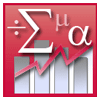Solidworks is a professional quality solid CAD software suite that is available for Windows. Solidworks is most famous for usage in engineering for design of physical objects, mechanics, and product design. It includes an elaborate simulation suite for stress testing, load testing, physics simulation, and structural integrity testing. Over 2 million engineers use Solidworks worldwide. It is also heavily used in 3D printing and fabrication.
Analysis & Modeling
Analysis refers to software intended to analyze data, whether it be mathematical, instrumental, quantitative, or qualitative. This category includes many research and statistical packages as well as graphing tools for showing data trends and correlations.
Modeling software focuses on the digital creation or the digital re-creation of a design. Modeling software allows for digital simulation to explore possibilities, theories, and simulate results. It also allows for easy viewing of the design from perspectives that would otherwise be difficult.
This category includes mapping tools, Geographical Information Systems (GIS) tools, plotting tools, landscape analysts, and geological structure tool. Also included is Software for statistical gathering, analysis, computation, and visualization. Often used in research, polling, or surveying.
Spartan
Spartan is a molecular modeling and computational chemistry application from Wavefunction. It contains code for molecular mechanics, semi-empirical methods, ab initio models, density functional models, post-Hartree–Fock models, and thermochemical recipes including G3(MP2) and T1.
Primary functions are to supply information about structures, relative stabilities and other properties of isolated molecules. Molecular mechanics calculations on complex molecules are common in the chemical community. Quantum chemical calculations, including Hartree–Fock molecular orbital calculations, but especially calculations that include electron correlation, are more time consuming in comparison.
Quantum chemical calculations are also called upon to furnish information about mechanisms and product distributions of chemical reactions, either directly by calculations on transition states, or based on the Hammond Postulate, by modeling the steric and electronic demands of the reactants. Quantitative calculations, leading directly to information about the geometries of transition states, and about reaction mechanisms in general, are increasingly common, while qualitative models are still needed for systems that are too large to be subjected to more rigorous treatments. Quantum chemical calculations can supply information to complement existing experimental data or replace it altogether, for example, atomic charges for QSAR analyses, and intermolecular potentials for molecular mechanics and molecular dynamics calculations.
Spartan applies computational chemistry methods (theoretical models) to a number of a standard tasks that provide calculated data applicable to the determination of molecular shape (conformation), structure (equilibrium and transition state geometry), NMR, IR, Raman, and UV/visible spectra, molecular (and atomic) properties, reactivity and selectivity.

